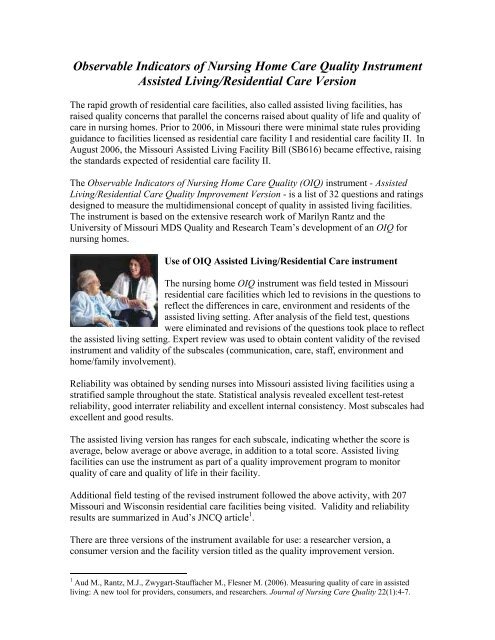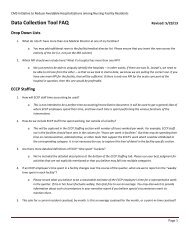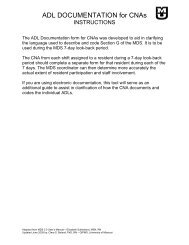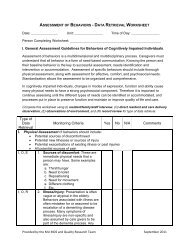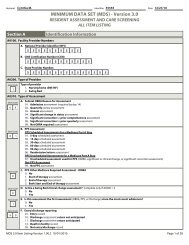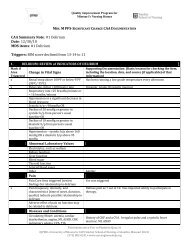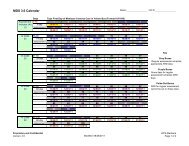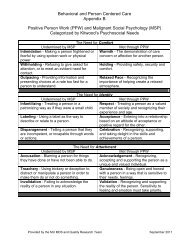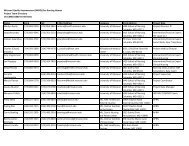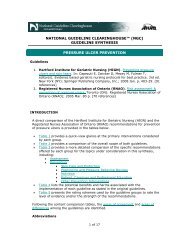Observable Indicators of Nursing Home Care Quality Instrument ...
Observable Indicators of Nursing Home Care Quality Instrument ...
Observable Indicators of Nursing Home Care Quality Instrument ...
You also want an ePaper? Increase the reach of your titles
YUMPU automatically turns print PDFs into web optimized ePapers that Google loves.
<strong>Observable</strong> <strong>Indicators</strong> <strong>of</strong> <strong>Nursing</strong> <strong>Home</strong> <strong>Care</strong> <strong>Quality</strong> <strong>Instrument</strong><br />
Assisted Living/Residential <strong>Care</strong> Version<br />
The rapid growth <strong>of</strong> residential care facilities, also called assisted living facilities, has<br />
raised quality concerns that parallel the concerns raised about quality <strong>of</strong> life and quality <strong>of</strong><br />
care in nursing homes. Prior to 2006, in Missouri there were minimal state rules providing<br />
guidance to facilities licensed as residential care facility I and residential care facility II. In<br />
August 2006, the Missouri Assisted Living Facility Bill (SB616) became effective, raising<br />
the standards expected <strong>of</strong> residential care facility II.<br />
The <strong>Observable</strong> <strong>Indicators</strong> <strong>of</strong> <strong>Nursing</strong> <strong>Home</strong> <strong>Care</strong> <strong>Quality</strong> (OIQ) instrument - Assisted<br />
Living/Residential <strong>Care</strong> <strong>Quality</strong> Improvement Version - is a list <strong>of</strong> 32 questions and ratings<br />
designed to measure the multidimensional concept <strong>of</strong> quality in assisted living facilities.<br />
The instrument is based on the extensive research work <strong>of</strong> Marilyn Rantz and the<br />
University <strong>of</strong> Missouri MDS <strong>Quality</strong> and Research Team’s development <strong>of</strong> an OIQ for<br />
nursing homes.<br />
Use <strong>of</strong> OIQ Assisted Living/Residential <strong>Care</strong> instrument<br />
The nursing home OIQ instrument was field tested in Missouri<br />
residential care facilities which led to revisions in the questions to<br />
reflect the differences in care, environment and residents <strong>of</strong> the<br />
assisted living setting. After analysis <strong>of</strong> the field test, questions<br />
were eliminated and revisions <strong>of</strong> the questions took place to reflect<br />
the assisted living setting. Expert review was used to obtain content validity <strong>of</strong> the revised<br />
instrument and validity <strong>of</strong> the subscales (communication, care, staff, environment and<br />
home/family involvement).<br />
Reliability was obtained by sending nurses into Missouri assisted living facilities using a<br />
stratified sample throughout the state. Statistical analysis revealed excellent test-retest<br />
reliability, good interrater reliability and excellent internal consistency. Most subscales had<br />
excellent and good results.<br />
The assisted living version has ranges for each subscale, indicating whether the score is<br />
average, below average or above average, in addition to a total score. Assisted living<br />
facilities can use the instrument as part <strong>of</strong> a quality improvement program to monitor<br />
quality <strong>of</strong> care and quality <strong>of</strong> life in their facility.<br />
Additional field testing <strong>of</strong> the revised instrument followed the above activity, with 207<br />
Missouri and Wisconsin residential care facilities being visited. Validity and reliability<br />
results are summarized in Aud’s JNCQ article 1 .<br />
There are three versions <strong>of</strong> the instrument available for use: a researcher version, a<br />
consumer version and the facility version titled as the quality improvement version.<br />
1 Aud M., Rantz, M.J., Zwygart-Stauffacher M., Flesner M. (2006). Measuring quality <strong>of</strong> care in assisted<br />
living: A new tool for providers, consumers, and researchers. Journal <strong>of</strong> <strong>Nursing</strong> <strong>Care</strong> <strong>Quality</strong> 22(1):4-7.
Example questions from the AL OIQ instrument follows:<br />
1. Were residents dressed and clean<br />
1 2 3 4 5<br />
Most were not Some were Many were Most were All were<br />
5. Were residents’ rooms personalized with furniture, pictures, and other things from their<br />
past<br />
1 2 3 4 5<br />
Most were not A few were Some were Many were Most were<br />
12. Were other unpleasant odors noticeable in the facility<br />
1 2 3 4 5<br />
Pervasive<br />
throughout<br />
In most areas Occasionally Hardly at all Not at all<br />
User Guide<br />
A four-page user guide is also available for use with the OIQ instruments. Individuals<br />
planning on using the instrument are encouraged to review the guide before completion <strong>of</strong><br />
the instrument.


